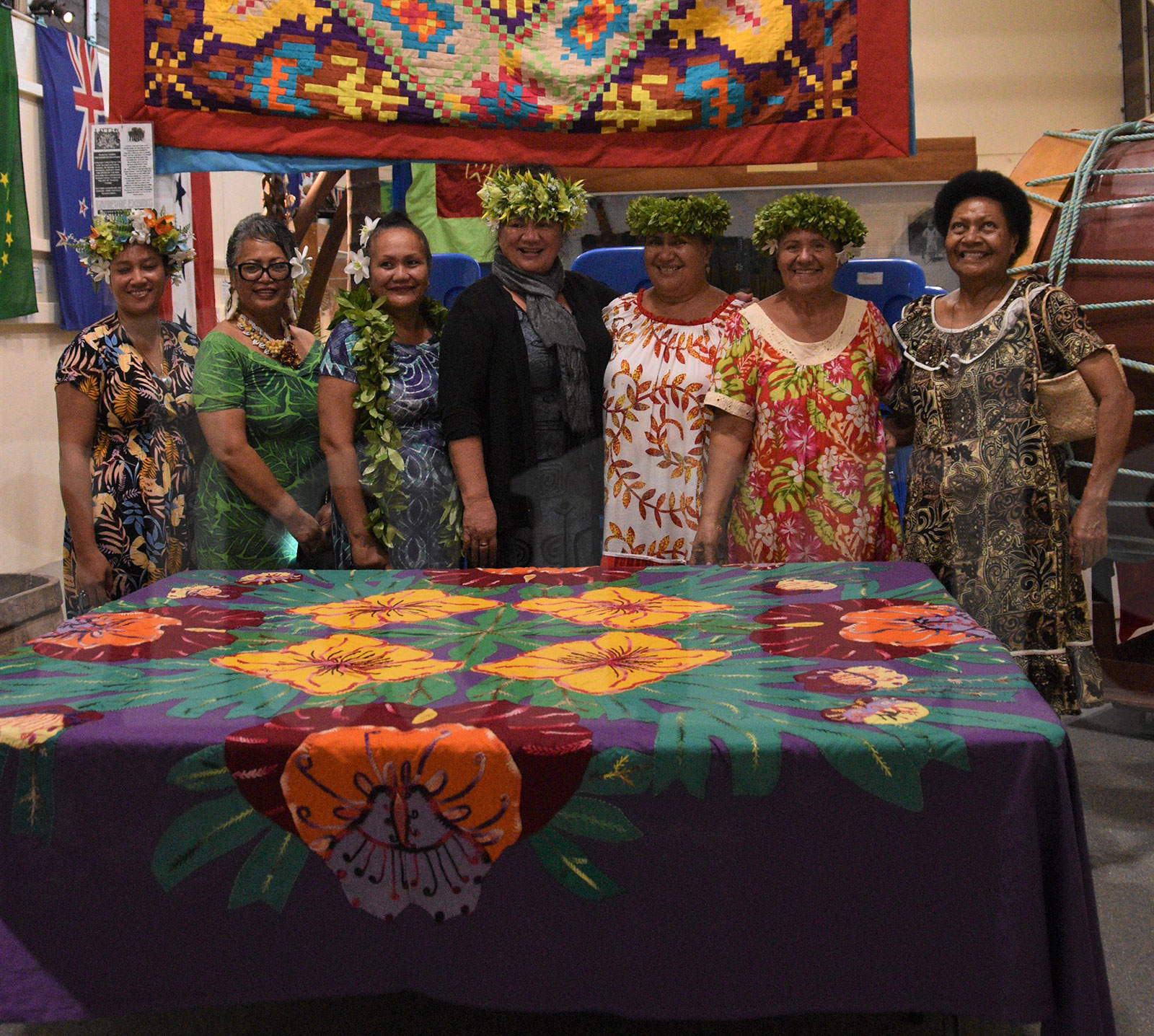Tivaivai exhibit showcases masterful needlework
Saturday 15 July 2023 | Written by Melina Etches | Published in Art, Features

Tivaivai sewn by the women sewn by the women of Enuamanu/Atiu with support of the New Zealand High Commission fund. MELINA ETCHES/23071406
The National Museum is hosting a vibrant exhibition celebrating the captivating artistry of tivaivai, a traditional quilt like textile masterpiece.
Tivaivai is a cherished art form that was introduced by the missionaries, it has since gained international recognition for its intricate designs and bold colour schemes.
Each piece is meticulously crafted by skilled hands, and the artistry and attention to detail is truly remarkable.
The aim of this National Council of Women (NCW) tivaivai project was to revisit, relearn, refine, and treasure the art of tivaivai taorei.
The idea came about two years ago after the island of Aitutaki Island celebrated their 200 years of the arrival of Christianity.
Taputu Mariri, the coordinator of the NCW wanted to proactively promote the tivaivai taorei (the small pieces sewn together ), as the art of the original taorei was increasingly being overtaken by the larger and simpler made tivaivai taorei.
With a grant fund by the New Zealand High Commission, workshops were hosted in Rarotonga, Mangaia, Atiu and Mauke to revisit and learn this art form of tivaivai.
Over 80 women attended these workshops, which also assisted the Cook Islands Christian (CICC) women’s efforts in these islands to prepare for their Arrival of the Gospel Bicentennial celebrations.
Vaine Wichman, President of NCW said: “Our women’s beautiful handicraft has evolved over the last 200 years since the missionaries arrived.
“It is important to respect and honour this work.
“Tivaivai is an important component of a woman’s love for her family and home.
“The significance of tivaivai is seen in its gifting to a special occasion for a family member. The tivaivai stays forever, money and food can go away, but not the tivaivai.
“It also captures a memory of the woman/women that made the tivaivai.
“Memories in our culture to help keep our traditions, our history,” said Wichman.
The exhibition displays a celebration of bold masterpieces intricately stitched by women who have spent countless hours honing their needlework skills.
Susan Sadaraka’s stunning ‘manu tataura’ (handstitched) tivaivai created from the ‘Ngutu’are Tangata (my family)’pattern, is impressive.
This is her most recent tivaivai which was finished in time for the unveiling of her mother Lois Sadaraka’s headstone in December 2022.
As a little girl, her grandmother Josephine Peterini Sadaraka in Aitutaki would visit her in Rarotonga.
She would try to inspire me to sew tivaivai, but I would say that this was something only old people did, said Susan.
As she grew older she learned to love culture and arts, particularly tivaivai and costumes.
When her daughter Leilani said she was getting married I made
Years later, before the wedding of her daughter Leilani, she set out to find a mama in Auckland, Aotearoa New Zealand who would teach her how to sew.
“I wanted to give my daughter a gift I had made myself.
“I sincerely thank my lovely aunty Tuakana Akanoa, a taunga o tivaivai for her support and patience.”
Her Tiare Tivaivai piece has white flowers in the centre which represent her parents and a brother who have passed on, the other flowers signify her sisters.
The surrounding flowers spread out over the fabric represents every single member of her Sadaraka family as at December 2022.
This piece is dedicated to my parents Sadaraka Metuakore Sadaraka and Lois Raewyn Sadaraka, in particular my mother would say “you are the reason I get up every morning”, said Susan.
Her grandson Makana Sadaraka-Peyroux will be the recipient of the tivaivai.
A bold and striking tivaivai taorei (small patchwork) was made by the women of Atiu/Enuamanu with support from the New Zealand High Commission funds.
The pattern of this taorei is called the ‘Chandelier and Chalice - Mori Tautau e te Kapu Oro’a’ which was designed by master tivaivai artist Tungane Broadbent.
Broadbent was inspired to create the pattern after visiting a “stunning” church in England where she was enthralled by the chalice, chandelier and lights.
By the time she returned home to Rarotonga, the pattern was already set in her mind.
“We respect and value her talent, she has also been so kind to share her pattern with our vainetini,” said Taputu Mariri.
Patikura Jim is from Nga Pu Toru - Atiu, Mauke, Mitiaro and Rarotonga with Chinese heritage.
Growing up in Atiu, she learned the art growing up with her paternal grandparents, cutting and sewing different types of tivaivai, pillow slips, cushions and covered table cloths to decorate their home.
Her spectacular tivaivai tataura (sewn with different stiches) is based on a hibiscus pattern.
Ngatokorima Rasmussen’s beautiful and striking tivaivai taorei was sewed from the pattern ‘Tairi e te Tiare’.
As a young girl she would help to take care of her older sister Tuanga’s children.
She would watch the women prepare their cutting and sewing for a taorei, they would use a mat to design their pattern, pieces were then shared out for each member to sew.
Rasmussen hand stitched her masterpiece piece on her own for her youngest daughter Tereapii’s wedding day.
The tivaivai exhibition will be on display for another three weeks, pop in and see these magnificent textiles showcasing the creativity of local women.




































